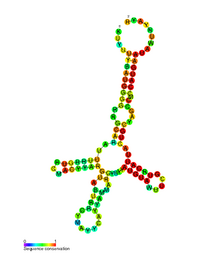mtDNA control region
| nucleic acid | |
|---|---|

|
|
| Map of the mtDNA with the mtDNA control region (gray and green) | |
| General | |
| Surname | mtDNA control region |
| other names |
|
| Identifiers | |
| GenBank | |
| properties | |
| Taxon | |
mtDNA control region (synonymous DLP region of ' D-loop and promoter region') is a non-coding section on the mitochondrial DNA (mtDNA) that controls the replication and transcription of the mtDNA.
properties
The mtDNA control region is the largest non-coding region of the mtDNA. Due to two hypervariable regions , it is also the area of the mtDNA with the most variable DNA sequence. It contains the mitochondrial origin of replication for one of the two DNA strands, the D-loop and both transcription origins . The variability is around 1.7%. Nevertheless, with the transcribed RNA there is a selection pressure to maintain the secondary structure . However, two deletions (of 50 base pairs and 154 bp) have been described with no effect on the mtDNA copy number. Certain variants of the mtDNA control region have an enlargedAssociated with perseverance .
Methods for differentiating DNA sequences of the mtDNA control region are DNA sequencing , d HPLC and microarrays .
Individual evidence
- ↑ Y. Michikawa, F. Mazzucchelli, N. Bresolin, G. Scarlato, G. Attardi: Aging-dependent large accumulation of point mutations in the human mtDNA control region for replication. In: Science . Volume 286, Number 5440, October 1999, pp. 774-779, PMID 10531063 .
- ↑ a b c M. Stoneking, D. Hedgecock, RG Higuchi, L. Vigilant, HA Erlich: Population variation of human mtDNA control region sequences detected by enzymatic amplification and sequence-specific oligonucleotide probes. In: American Journal of Human Genetics . Volume 48, Number 2, February 1991, pp. 370-382, PMID 1990843 , PMC 1683035 (free full text).
- Jump up ↑ S. Anderson, AT Bankier, BG Barrell, MH de Bruijn, AR Coulson, J. Drouin, IC Eperon, DP Nierlich, BA Roe, F. Sanger, PH Schreier, AJ Smith, R. Staden, IG Young: Sequence and organization of the human mitochondrial genome. In: Nature . Volume 290, Number 5806, April 1981, pp. 457-465, PMID 7219534 .
- ↑ CF Aquadro, BD Greenberg: Human mitochondrial DNA variation and evolution: analysis of nucleotide sequences from seven individuals. In: Genetics. Volume 103, Number 2, February 1983, pp. 287-312, PMID 6299878 , PMC 1219980 (free full text).
- ↑ F. Pereira, P. Soares, J. Carneiro, L. Pereira, MB Richards, DC Samuels, A. Amorim: Evidence for variable selective pressures at a large secondary structure of the human mitochondrial DNA control region. In: Molecular biology and evolution. Volume 25, Number 12, December 2008, pp. 2759-2770, doi : 10.1093 / molbev / msn225 , PMID 18845547 .
- ↑ R. Bi, AM Zhang, W. Zhang, QP Kong, BL Wu, XH Yang, D. Wang, Y. Zou, YP Zhang, YG Yao: The acquisition of an inheritable 50-bp deletion in the human mtDNA control region does not affect the mtDNA copy number in peripheral blood cells. In: Human mutation. Volume 31, number 5, May 2010, pp. 538-543, doi : 10.1002 / humu.21220 , PMID 20151402 .
- ↑ H. Murakami, A. Ota, H. Simojo, M. Okada, R. Ajisaka, S. Kuno: Polymorphisms in control region of mtDNA relates to individual differences in endurance capacity or trainability. In: The Japanese journal of physiology. Volume 52, Number 3, June 2002, pp. 247-256, PMID 12230801 .
- ^ T. Melton, C. Holland, M. Holland: Forensic Mitochondrial DNA Analysis: Current Practice and Future Potential. In: Forensic science review. Volume 24, Number 2, July 2012, pp. 101-122, PMID 26244267 .

